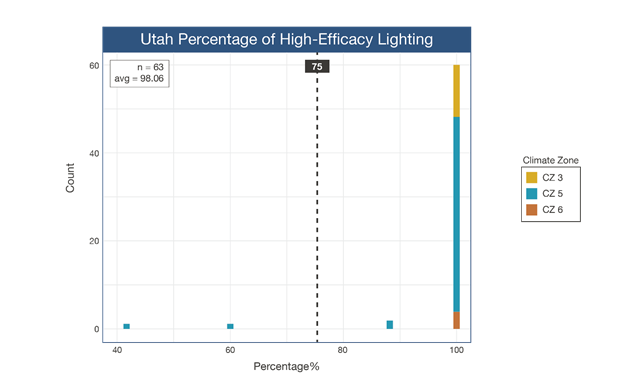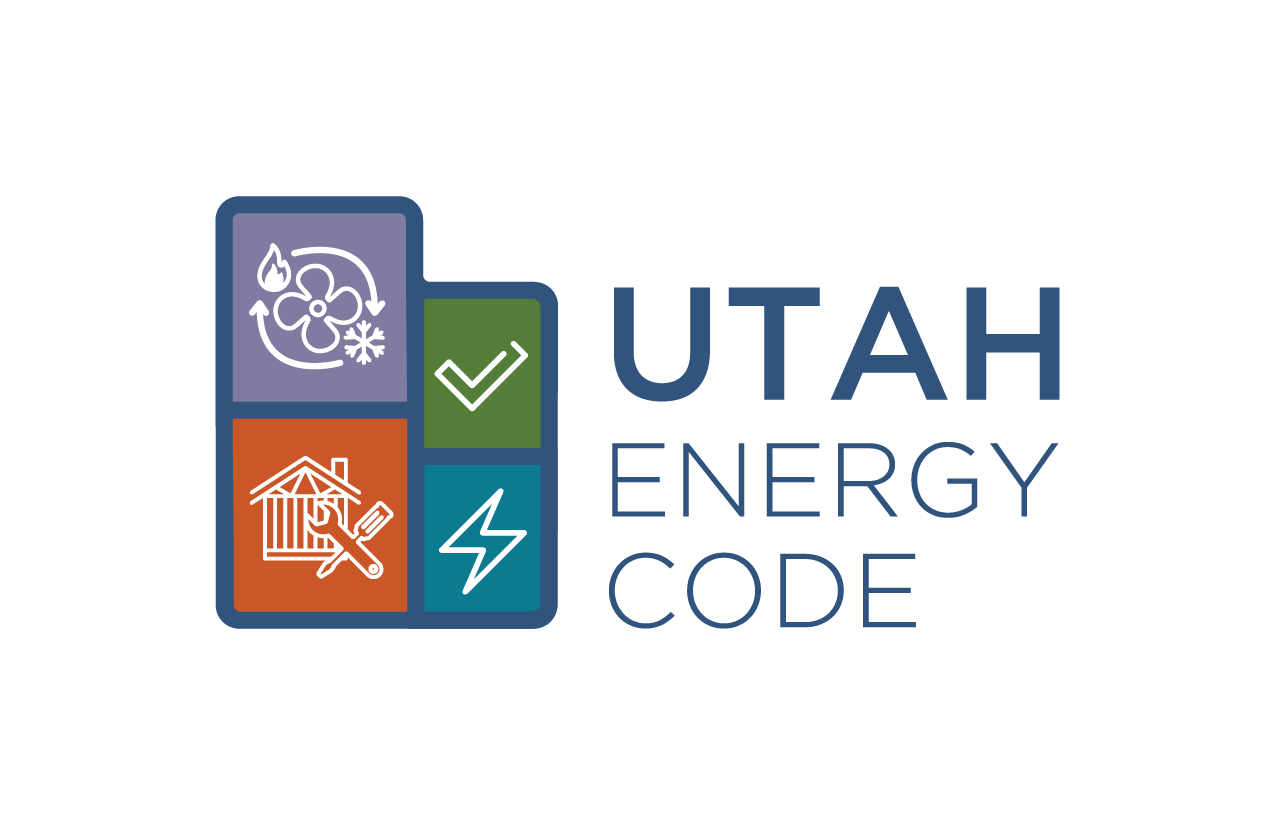
Utah’s Residential Energy Code Field Study Shows a Big Opportunity for Cost Savings and Emissions Reductions
New homes built in Utah can lock in long term financial savings by preventing energy waste. The key to achieving this is in the International Energy Conservation Code, otherwise known as the “IECC” or simply the “energy code.” The energy code sets a baseline for energy efficiency in all new construction and major remodels. Energy efficient construction supports home affordability by lowering utility bills for homeowners and renters, providing a comfortable living environment. An energy efficient home also helps reduce carbon emissions since it uses less energy.
About the Study
In June of 2019, the United States Department of Energy launched a Residential Energy Code Field Study in Utah. The study was designed to do three things:
-
-
- Assess to what degree new residential construction in Utah meets the current energy code
- Develop energy code trainings to address any compliance gaps identified in the study
- Estimate the energy, cost, and emissions savings potential if new homes in Utah achieve 100% compliance with Utah’s current residential energy code
-
The study was led by the Institute for Market Transformation, using methodology developed by Pacific Northwest National Laboratory (PNNL) with partnership and support from Resource Innovations (formerly Nexant), WC-3, Utah Office of Energy Development, Utah Clean Energy, Rocky Mountain Power, Dominion Energy, and the Southwest Energy Efficiency Project .
How Data was Gathered
Field data for the study was collected from 127 sample Utah homes between March 2020 and December 2020 (with significant delays due to Covid-19). The samples came from new residential construction sites in 35 cities across 9 counties, which were identified by a random selection process. A local stakeholder group confirmed that the sample sites were representative of Utah’s climate zones, population, demographics, and construction activity. Data was collected and analyzed following the methodology developed by PNNL to achieve a statistically valid sample for residential energy code compliance assessments. (More information about the U.S. DOE’s Residential Energy Code Field Studies)
While not part of the PNNL methodology, this project also collected information about which home sites participated in utility sponsored energy efficiency rebate programs. Utah has two investor-owned utilities, Rocky Mountain Power (electric utility), and Dominion Energy (natural gas utility), both of which sponsor energy efficiency rebate programs. Of the samples collected through this study, 57% reported participating in at least one utility energy efficiency program, while 21% of sites reported participating in both an electricity and natural gas efficiency rebate program. While these programs do increase the efficiency of buildings that participate, it is unclear what role these programs may play in promoting energy efficient building practices that directly influence energy code compliance. What is clear is that the study shows that large economic and environmental gains can be made through increasing residential energy code compliance.
Results: Energy Savings Potential of Full Energy Code Compliance
The study found that if contractors and local building departments across Utah achieve full compliance with Utah’s residential energy code, Utah residents living in homes built fully in line with the current energy code would collectively cut their energy bills by $1.3 million each year. This amount of energy savings translates into preventing over 17,000 metric tons of carbon emissions annually .
Building Practices with Strong Levels of Code Compliance:
-
-
- High efficacy lighting: Great news! On average, 98% of the new homes sampled exceeded the energy code’s requirement for “high efficacy” lighting. In other words, most lights that are installed in new homes today are energy-saving LEDs (or something equivalent). This is a simple way to provide superior lighting quality and keep electricity costs low for new homebuyers.
-

- Envelope tightness: Sealing new homes to prevent air leakage is arguably one of the most important strategies to conserve energy. According to the study, Utah’s current rate of envelope tightness shows an average air tightness of 3.03 air changes per hour (ACH), slightly tighter than the current energy code requirement of 3.5 ACH. While the average rate of airtight construction was very positive, there were several samples that indicate a notable number of homes are being built without the minimum level of air tightness, which suggests there is still room to improve. (Note: as homes become more airtight, mechanical ventilation is essential to protect indoor air quality from excessive moisture, combustion byproducts, etc.) Estimated savings from improved envelope tightness compliance: $76,000 per year and 430 metric tons of avoided carbon emissions annually.

Building Practices with Low Compliance:
- Ceiling insulation: When analyzing the R-value of ceiling insulation, the average amount of ceiling insulation in new Utah homes is low, showing an average of R-39.8 (the current energy code requires R-38 in Southern Utah, but it is R-49 across most of the state). In addition, when analyzing the average U-factor of installed ceiling insulation, the insulation performance comes in at 0.031 U-factor (less efficient than the requirement of 0.026 in climate zones 5 and 6 and 0.03 in Southern Utah. This is probably due to installation problems and shows a need for improving how insulation gets installed in new homes. Estimated savings from improved compliance: $99,000 per year and 2,000 metric tons of avoided carbon emissions.


- Duct leakage: According to data collected during the study, the average air duct system is tighter than Utah’s code requirement at 4.61 cfm/100 ft2 when only assessing ducting located entirely outside of the building envelope (as compared to the energy code requirement of 7 cfm post-construction or 6 cfm rough-in with air handler/8 cfm rough-in without air handler). However, when the tightness of ductwork located inside the building envelope is included as well, the average duct tightness rate grows to 11.1 cfm/100 ft2, significantly leakier than what the energy code allows. This finding suggests that the rate of duct leakage for ducts located inside of the building envelope could be improved significantly. Estimated saving from improved compliance: $241,000 per year and 4,600 metric tons of avoided carbon emissions annually.


-
Exterior wall insulation: When looking at the R-value of insulation installed in above frame walls, compliance looks okay, but when assessing the U-factor value of above frame walls, compliance takes a major dip. As with ceiling insulation, this finding suggests that the quality of the installation of wall insulation is a problem in Utah. U-factor more accurately represents the true performance of wall insulation and accounts for “thermal bridging” – a major pathway for energy and heat loss. Estimated saving from improved compliance: $620,000 per year and 11,400 metric tons of avoided carbon emissions annually.

In summary, this study shows that improved energy code compliance in Utah can benefit homeowners’ pocketbooks and our climate significantly by cutting energy consumption and utility costs, while also lowering emissions that result from energy use.
What’s next?
The U.S. Department of Energy recently approved the second phase of this project. In the second phase, the gaps in energy code compliance explained above will be addressed in targeted energy code training starting in 2022. This training is expected to be offered as part of the Building Talks: Utah’s Energy Code Training Program, administered by the Office of Energy Development. Sign up for the Utah Energy Code Training mailing list on this webpage.
For more graphs related to this blog click here.
(Note: the Utah Energy Code Training Program is sponsored by the Rocky Mountain Power Wattsmart program and the Dominion Energy ThermWise program and administered by the Utah Office of Energy Development. Thank you to the Utah Office of Energy Development, Rocky Mountain Power, and Dominion Energy for supporting this important program!)
– Dr. Energy

0 Comments